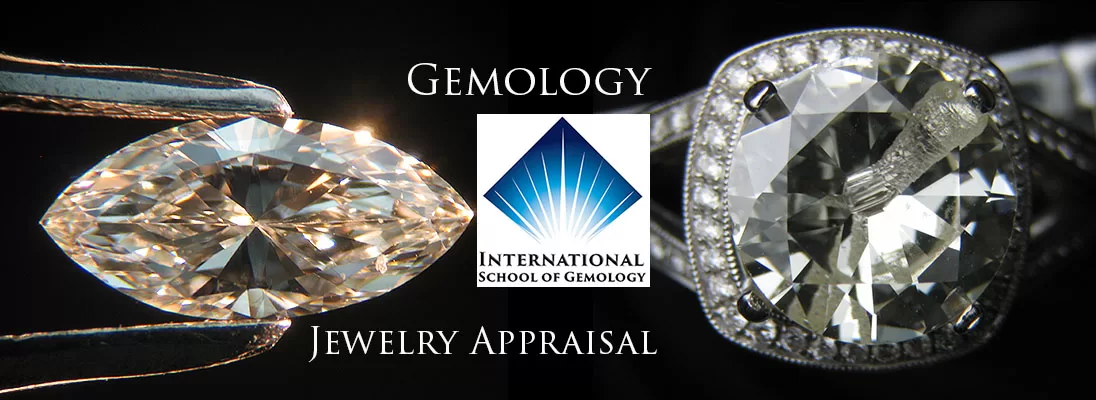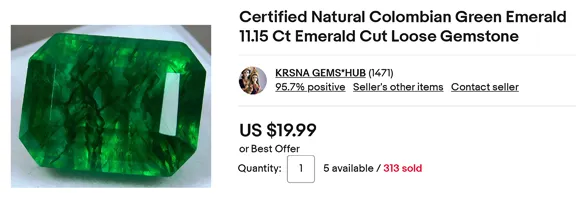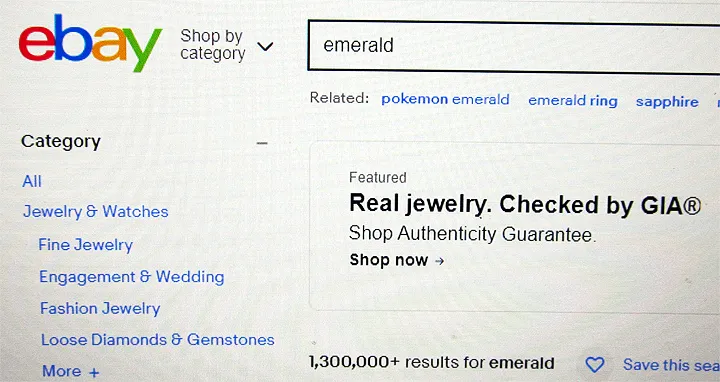Please sign in first
Not a member?

- Home
- Online Education Programs
- RG/RGA Legacy Entrance
- ISG Credentials
- Frequently Asked Questions
- Registry of Graduates
- Careers in Gemology
- Important Program Information
- Newsletters
- Identifying Lab Created Diamonds
- Black Diamond or Created Moissanite?
- Ebay, the GIA, and Section 230
- Lessons From the Angry Janitor
- Exposing the Truth about Lab-Created Diamonds
- AGTA Hobbles Dealers and Buyers
- Appraisers -v- Gem Labs…a Legal Imbalance!
- Understanding the Classification of Diamonds
- Cremation Diamonds: Insuring and Litigating
- Let’s Talk About Gemology Credentials
- Hometown Jewelers and the Force Majeure Clause
- Following the Critical Angle of Diamond Grading
- When Breitling Brought the Airmen Home
- Let’s Open a Refractometer
- Measuring the Energy of Light
- Quick Reference Guide to Sunstone
- ISG Seeing the Invisible Light
- Contact Us
Ebay, the GIA, and Section 230
Ebay, the GIA, and Section 230

As a state-licensed Property and Casualty Insurance Adjuster and investigator specializing in high-value jewelry claims, I have seen a side of this industry that most of you don’t see. And, quite honestly, don’t want to see. It’s not the false claims and misrepresentation that we see from time to time. Those things happen in every industry and have been a part of doing business for centuries. I am talking about the blatant ethical abuse by the online selling venues and the alarming, alleged collusion by certain major jewelry industry organizations.
A striking instance of this is the GIA’s decision to send the editor of their Gems and Gemology publication on an expedition to a copper-bearing andesine mine in the high desert of Tibet. The publication heralded the trip, claiming it had settled the debate about the mine’s existence. However, shortly after, a team from the National Gem Testing Centre of China visited the site and discovered no mine but a warehouse brimming with artificially treated feldspar.
The obvious question is: What happened? And who should we believe?
Now, the question that looms large for gemstone customers is: Who should we trust in this industry?
Here is a case in point. In the banner of this newsletter, you see an offer for a “Certified Natural Colombian Green Emerald” for sale for US$19.99 or the best offer. Now, before anyone says: “That’s absurd; no one would believe that,” look more closely. There were 313 people who believed it. Over the years, I have contacted buyers of these kinds of online offers, and these folks believe that since the offers are on eBay, Etsy, Amazon, etc.… they must be genuine.

For the record, the gemstone for sale above is actually a green-dyed quartz. We have several of these in the ISG Student Reference Collection and pay about $2 a piece for them.
No one, not even those in the gemstone industry, is considering the impact of U.S. Code Title 47 Section 230 on this emerald sale. As published in the Legal Information Institute of the Cornell Law School, Section 230 (c) states:
(c)Protection for “Good Samaritan” blocking and screening of offensive material
(1)Treatment of publisher or speaker
No provider or user of an interactive computer service shall be treated as the publisher or speaker of any information provided by another information content provider.
In other words, eBay, Etsy, Amazon, et al. are not legally liable for false or malicious misrepresentations made by sellers on those venues. If a consumer wants to take action for a falsely represented gemstone purchase, in this and many other cases, they quite literally have to hire an attorney in India and take legal action against the seller in the Indian courts. Yeah….I know what you’re thinking, but that is just how it works.
But it gets worse.
In the screenshot below, taken today from my computer, you see “Real Jewelry, Checked by the GIA ®” on the eBay page showing 1,300,000 listings for emeralds. While the “checked by” may refer to a limited number of sales that are checked, to consumers it appears that the GIA checks and endorses all eBay emerald sales. That was my impression.

Why is the GIA lending its logo and name to this practice? I don’t know. I do know that eBay is making it appear like it is doing due diligence because I have contacts from U.S. dealers who have been put through the wringer with eBay checking stones, while at the same time, hundreds of these sales from dealers in India go unchecked, as we see here. Why? The same reason consumers don’t do anything…these guys are in India. And, of course, eBay makes money even on these bogus sales while being protected by Section 230.
Conclusion
The hometown independent retail jeweler competes with this every day. You may not fully realize it but think about how much of your customer traffic shops on the internet before or after shopping with you.
Consumers are not being told that there is no legal protection for them regarding internet purchases. When a customer buys an emerald from a hometown jeweler, they have a guarantee of authenticity, or else there are legal remedies if problems arise. But if one buys an emerald off of eBay, Etsy, Amazon, or other online venues, the seller can totally misrepresent the item for sale (as we saw above), and these venues can be fully aware of the fraud, and nothing can be done.
The bottom line is the hometown jeweler is on our own. The JVC and other industry organizations are obviously doing nothing to help. The U.S. Title 47, Section 230 protects the practice. We are indeed on our own.
It is time that the hometown, independent jeweler takes action to deal with this. No one else is going to, I assure you. Contact your Congress member or U.S. Senator and voice your concern over Section 230.
That is my opinion, I welcome you to send in yours.
Robert James FGA, GG
International School of Gemology